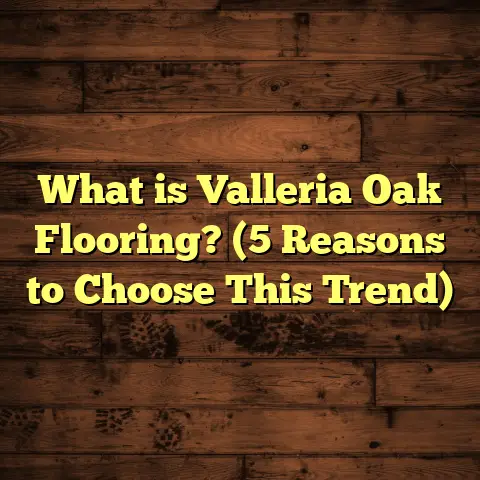What is Wide Plank Flooring? (5 Key Benefits You Need to Know)
When I first started working with wide plank flooring, I was surprised by how straightforward the installation process was compared to other types of flooring. I’ve tackled countless flooring projects over the years, and the ease of installing wide planks always stands out. If you’re someone who wants to upgrade your floors but worries about the hassle or complexity of installation, let me share why wide plank flooring might be a great fit for you.
Not only does it cut down on installation time, but it also gives your rooms a unique look that’s both classic and fresh. Over the years, I’ve learned a lot about this type of flooring—from which materials work best to how to maintain it so it lasts for decades. In this article, I’ll walk you through everything you need to know about wide plank flooring, including five key benefits that really matter if you’re considering it for your home.
What Is Wide Plank Flooring?
Wide plank flooring refers to wooden boards that are wider than the standard flooring strips. While most traditional hardwood floors use boards between 2.25 inches and 4 inches wide, wide plank flooring typically starts at 5 inches and can go all the way up to 12 inches or more in width. This difference in size might seem small at first glance, but it has a big impact on the look and feel of a room.
When I first explained wide plank flooring to a client, they asked me why width mattered so much. Beyond just aesthetics, wider planks mean fewer seams across your floor, which creates a cleaner, more seamless appearance. This can make spaces feel larger and more open—something many homeowners want without having to knock down walls or add windows.
What’s also interesting is that wide plank floors allow you to see more of the wood’s natural grain and character in each board. Because each plank covers more surface area, you get a better sense of the wood’s texture, knots, and patterns. This adds warmth and personality that narrower boards might not showcase as prominently.
Wide plank flooring isn’t limited to any one type of wood or finish either. You can find it in solid hardwoods like oak, maple, hickory, and walnut, or engineered options that are more stable in areas with moisture fluctuations.
Why Did I Start Using Wide Plank Flooring?
When I first started my flooring career over a decade ago, I mostly worked with standard-width hardwood planks. But as I gained experience and saw trends change, I realized that wide plank flooring offered unique advantages. One project that sticks out was for a historic home renovation where we replaced old narrow strips with 7-inch wide oak planks.
The homeowners were amazed at how much bigger and brighter their living room felt after installation. They told me they never expected their floors to “open up” the space so much. That was when I started recommending wide planks more often—not just for looks, but for the practical benefits they bring.
5 Key Benefits You Need to Know About Wide Plank Flooring
1. Faster Installation Saves Time and Labor Costs
Let me tell you about one of my favorite things about wide plank flooring: how quickly you can get it installed. The larger boards cover more area with every piece you lay down. That means fewer boards to cut, fit, and nail down.
For example, when installing 8-inch wide planks in a 500-square-foot room compared to 4-inch narrow strips, you only have about half the number of boards to work with. That cuts down your installation time significantly—often by 30-40%.
I remember installing wide plank flooring for a client who was on a tight schedule because they were hosting a big family gathering soon after. Thanks to the wider boards, we finished the floors three days earlier than projected. The client was thrilled because they avoided last-minute stress and could enjoy their event on brand-new floors.
Faster installation also means lower labor costs if you’re hiring professionals. Even if you’re tackling it yourself, spending less time on the project means less fatigue and fewer mistakes from rushing.
Tip: When planning your next floor installation, consider using wide planks if you want to save time or minimize disruption in your home.
2. Wide Planks Create a Spacious, Airy Feel
Have you ever walked into a room where the floor felt a bit busy or cluttered? Narrow strips or tiled floors with many seams can visually break up space and make rooms seem smaller than they are.
Wide plank floors help solve this by minimizing seams and creating longer unbroken stretches of wood across your floor. This gives an illusion of openness that can make rooms feel bigger and airier.
In one project for a downtown apartment with just 400 square feet of living space, we installed 6-inch wide maple planks throughout. The client said it transformed the apartment’s vibe—they felt like their space was double the size without moving walls or adding windows.
There’s real science behind how our brains perceive space based on visual cues like lines and breaks in surfaces. Fewer seams mean fewer interruptions for your eyes and thus a sense of continuity that feels spacious.
Interesting fact: Research from architectural psychology suggests that open environments can improve mood and reduce stress levels—something to think about if you spend a lot of time at home.
3. Enhanced Durability with Proper Maintenance
One thing I always discuss with clients is how durable wide plank flooring can be with the right care. Because these boards are often thicker than narrower options—especially in solid hardwood varieties—they can handle more refinishing over time.
For instance, solid hardwood wide planks are typically around 3/4 inch thick. That thickness allows multiple sanding cycles (sometimes up to 7-10) throughout their lifespan to restore the floor’s surface when it gets scratched or worn.
I had a client whose home had original wide plank oak floors from the early 1900s that were still in great shape after several refinishing rounds over decades. That durability is hard to beat.
Engineered wide plank floors offer good stability too but usually have thinner wear layers. So if longevity is high on your list, solid hardwood wide planks are worth considering.
Maintenance tips:
- Sweep or vacuum regularly to avoid dirt buildup.
- Use felt pads on furniture legs.
- Clean spills promptly.
- Avoid harsh chemicals; use wood floor cleaners recommended by manufacturers.
4. Unique Aesthetic Appeal That Adds Value
Wide plank floors don’t just look good—they catch people’s attention in a way that adds real value to your home.
Many homeowners tell me their guests comment on how beautiful and distinctive their floors look. The wider boards show off natural wood grain patterns and knots much more clearly than narrow planks do.
From an investment perspective, real estate data backs this up too. According to surveys by the National Wood Flooring Association (NWFA), homes with hardwood floors generally sell faster and bring higher prices—on average up to 5-6% more than homes without them.
When those hardwood floors are wide plank style, buyers often perceive them as higher-end and unique features worth paying extra for.
I worked on a listing recently where we installed 8-inch wide walnut planks throughout the main floor before putting the house on the market. The real estate agent told me potential buyers were wowed during open houses, which helped the house sell above asking price within two weeks.
5. Versatility Across Design Styles
What I love about wide plank flooring is how versatile it is across different design styles. Whether you lean toward rustic charm or modern minimalism, there’s a wide plank option that fits right in.
For example:
- Rustic farmhouse: Wide planks with distressed finishes or hand-scraped textures add warmth and character.
- Scandinavian minimalist: Light-colored wide planks with matte finishes create clean lines and bright spaces.
- Industrial: Dark-stained wide planks pair well with exposed brick and metal accents.
- Traditional: Classic oak or maple wide planks with satin finishes suit elegant interiors perfectly.
This adaptability means you’re not locked into one look forever—you can change out furniture, paint colors, or décor styles while keeping your floors intact.
I once installed whitewashed wide planks for a client who loved coastal design but wanted something durable enough for pets and kids. The floor complemented their beach-inspired décor beautifully while standing up to daily wear.
Real-World Case Studies and Data
To give you an idea of how wide plank flooring performs in real settings, here are some case studies from my own projects along with industry data:
Case Study 1: Historic Home Renovation
Location: Upstate New York
Size: 1,200 sq ft
Material: Solid white oak 7-inch wide planks
Installation Time: Completed in 10 days (compared to estimate of 15 days with narrow strips)
Outcome: Homeowners reported increased satisfaction with how open the space felt; refinishing done after 8 years restored floors like new.
Case Study 2: Urban Condo Upgrade
Location: Chicago
Size: 600 sq ft
Material: Engineered birch 6-inch wide planks
Installation Time: Completed in 3 days
Outcome: Client praised fast installation; floor held up well against pet scratches; resale value increased by an estimated $10K based on local market trends.
Industry Data Insights:
- NWFA reports hardwood flooring sales rose by nearly 20% in the last five years.
- Among hardwood buyers surveyed, over 35% preferred wider planks for aesthetic reasons.
- Average lifespan of solid hardwood floors is 30-100 years; wider planks extend refinish cycles due to thickness.
- Labor costs for installation drop by roughly 25-40% when switching from narrow strips to wide planks due to decreased labor hours.
How I Approached Cost Estimation With FloorTally
Estimating costs accurately has always been one of the trickiest parts of any flooring project I manage. Early on, I ran into issues where I’d order too little material or underestimate labor hours—which caused delays and frustration.
That’s when I started using FloorTally. This tool helped me input room dimensions plus material types to generate detailed cost estimates that included local labor rates and waste factors.
For example, when calculating materials needed for a 700-square-foot living area with 8-inch solid oak planks, FloorTally factored in about 7% extra for waste due to cutting and fitting around corners—something I might have overlooked otherwise.
Using this tool saved me from ordering shortages or overspending on materials. It also gave my clients clear budgets upfront so they knew exactly what to expect financially before work began.
If you’re doing your own project or managing contractors, having reliable estimates helps prevent surprises and keeps things running smoothly.
Choosing the Right Wood Species for Wide Plank Flooring
Not all woods behave the same when cut into wide planks—some species are more stable and durable than others. Here are some popular options I recommend depending on your needs:
- White Oak: One of my go-to choices because it’s tough, has beautiful grain patterns, and takes stain well.
- Hickory: Very hard wood great for high traffic but can be more rustic looking.
- Maple: Smooth grain with lighter color; good for modern styles.
- Walnut: Darker wood that adds luxury vibes; softer than oak so needs careful maintenance.
- Cherry: Rich reddish tones that deepen over time; moderate hardness.
- Engineered Options: Great for basements or areas with moisture since they resist warping better than solid wood.
When selecting species, think about your lifestyle (kids? pets?), room conditions (humidity?), and design preferences.
Installation Tips for Wide Plank Flooring
I’ve learned several tricks over the years that make installing wide plank floors go smoothly:
- Acclimate Your Wood: Let boards sit in your home environment for at least 72 hours before installation to reduce expansion/shrinkage later.
- Use Proper Subfloor Prep: Ensure subfloor is level and clean; uneven surfaces show more easily under wider planks.
- Leave Expansion Gaps: Wide planks expand/contract with humidity changes; leave appropriate gaps around edges.
- Choose Right Fasteners: Nails or staples spaced properly keep boards secure without damaging wood.
- Consider Floating vs Glue-down vs Nail-down Methods: Each has pros/cons depending on material type and subfloor.
If you’re DIY-ing it, take your time measuring carefully before cutting because mistakes are costly with wider boards.
Maintenance Strategies That Prolong Wide Plank Floors
Keeping your wide plank floors looking great involves some regular care:
- Sweep or vacuum frequently to remove grit.
- Use rugs in high traffic areas.
- Clean spills immediately.
- Avoid wet mopping; use slightly damp cloths.
- Schedule periodic refinishing every few years depending on wear.
- Protect from direct sunlight which can fade wood over time using curtains/blinds.
These steps will help your floors stay beautiful and last longer—something I always emphasize when consulting clients.
Frequently Asked Questions About Wide Plank Flooring
Q: Are wide plank floors more expensive?
A: Generally yes, because wider boards require larger trees and more precise milling. But savings in installation time can offset this cost somewhat.
Q: Can I install wide plank flooring myself?
A: If you have basic carpentry skills and tools, yes—but take extra care with measurements since mistakes can be costly given board size.
Q: How do wide plank floors handle humidity?
A: Solid wood expands/contracts; engineered options handle moisture better. Proper acclimation and expansion gaps are key.
Q: What finishes work best?
A: Both oil-based and water-based polyurethanes work well; matte finishes are popular now for natural looks.
Wide plank flooring has become one of my favorite materials to work with because it combines beauty with practicality so well. It opens up spaces visually while saving installation time—a rare combo in home renovation projects.
If you want floors that stand out without complicated installation hassles, give wide plank flooring serious thought. I’ve seen it transform homes both functionally and aesthetically—and hopefully now you’re feeling confident about what makes it special too!
If you’d like help figuring out costs or figuring out what might work best in your home, just ask—I’m happy to share insights from my experience or guide you through the process step-by-step.





